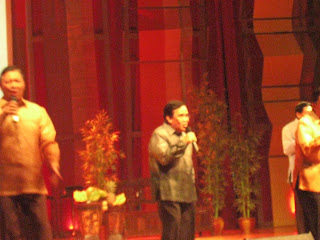Pagu-ulat Tungkol sa Industriya ng Pabo sa Pilipinas
By Elmer R. Esplana
(Mayo 27, 2011)
Ang industriya ng pagaalaga ng pabo or “turkey industry” sa Pilipinas ay nasa “infancy stage” pa lang. Halos, ilan-ilan lang ang nag-aalaga ng pabo para sa “commercial purposes. ” Ang mga nag-aalaga ng pabo sa ibang bansa ay kalimitang white broad breasted turkey breed. Ang breed na ito ay unang ginamit para sa commercial purposes noong mga 1950’s at noong 1960’s, marami sa mga nasa turkey industry sa Estado Unidos ng Amerika (United States), Canada, etc., ay ito ang breed na ginagamit sa kanilang pag-aalaga. Ang mga breeds ng pabo ay Royal Palm, Bronze, Black and Narraganset. Ang pinakamabili na “breed” ng pabo ay Black turkey tulad ng inaalagaan ng Herbest Turkey Products sa Rizal at ang nasa National Swine and Poultry Research Center ng Bureau of Animal Industry sa Tiaong, Quezon.
Ang pagaalaga ng pabo ay ginagawa lang na “hobby” ng ilan o kaya bilang “pet animal.” Mayroon ding ilan na ito ay nasa mga zoo sa ibat-ibang lugar sa Pilipinas. Kalimitang mayayaman at may kaya lang ang kumakain nito sa bansa dahil sa mahal ang presyo nito per kilo (P400 to P450) para sa dressed turkey meat. Mayroong alaga ang BAI sa Tiaong, Swine and Poultry Research Center, ngunit itoy ilan lang. Kalimitang, ina-angkat (imported) pa natin ang mga lahi ng pabo. Ang karni ng pabo “turkey meat” ay kilala na walang cholesterol na karmi di tulad ng manok.
Katulad ng manok at bibi, lahat ng bahagi ng pabo ay pweding mapakinabangan. Pwedi ring i-proseso ang balat nito at gawing pagkain ang mga lamang loob, sa halip na laman lang. Ang balahibo ay pweding gawing materyales sa pamaypay (fan) at ibang pang “ornamental products” pang dekorasyon sa bahay at mga opisina.
Ang average price ng isang kilo ng pabo na “liveweight” ay P150 to P250/kilo. P400 to P450 naman mabibili sa mga supermarkets na nag-titinda nito ang kada kilo ng “frozen dressed turkey meat,” isang halimbawa ang SM Supermarket. Kalimitang imported ito. Ang isang buong pabo (dressed turkey) ay nagkakahalaga ng mga P1,200 to P1,500/ulo (head), mga 2.8 to 3.5 kilo isang buo.
Sa ngayon, gaya ng sabi ko, nasa infancy stage pa lang ang pabo. Ito ay isang emerging industriya kabilang sa “poultry industry” ng bansa. Ang “commercial market” ng pabo ay maliit pa lang at kalimitang mga “institutional buyers” ang mercado nito tulad ng mga ilan-ilang hotels, restaurants, supermarkets at mamimili na may mga kayang pamilya or banyaga (foreigners). Pwedi nating maakit ang ating mga kababayan na pasukin din ang “turkey raising” bilang alternatibo or complementary sa chicken raising kung maitataas pa ang level ng demand ng turkey meat para sa mga “high-end niche market” nito. Kailangang din gumawa ng “industry analysis” at ibat-ibang scheme ng bilang ng aalagaan (halimbawa, 20 ulo, 50 ulo, 100 ulo, atbp), kung magkano ang puhunan at kung magkano ang kita kada ulo at ung “economics of scale” para sa “commercial scale operation.”
Sa ngayon, may programa ang Bureau of Animal Industry, kaya lang hindi sya gaano “priority” ng Department of Agriculture. Pwedi ang National Swine and Poultry Research Center ng BAI ay mag conduct ng training o seminar para sa mga interesadong mag-alaga ng pabo. Maengyanyo din natin ang mga kababayan na mag-alaga ng pabo kung magiging mataas ang demand ng karmi ng pabo para sa mga high-end niche market nito sa bansa. Mas mataas ang level ng market demand mas marami ang mag-invest sa pag-aalaga ng pabo lalo na ang “commercial scale operation” o “turkey agribusiness.”
Kailangang pang i-develop ang mercado ng pabo upang mas madagdagan ang mga nasa negosyon ng processing ng pabo. Kung magiging malaki ang market nito, mas marami ang magkaka-interest na mag-alaga at mag- process na rin ng karni ng pabo, katulang ng pagbibinta ng “dressed turkey meat product”.
Ang pabo ay kalimitang ihinahanda sa Estado Unidos dahil sa pagdiriwang ng “Thanksgiving Day” tuwing ika dalwamput lima (25) ng Nobyembre kada taon. Ang pabo na naggagaling sa mga magsasaka sa Minnesota, Estados Unidos ay ginagawang niche product para sa bansang Tsina (People’s Republic of China). Gumawa sila ng kakaibang luto ng galing sa pabo ayon sa Department of Agriculture ng Mimmesota, Estados Unidos. Ito ay pinuposisyon nila hindi ka-kompetensya ng karni ng baboy, kundi bilang mataas na uri ng karmi (higher value meat).
Sa Pilipinas, ang kadalasang bumibili ng “dressed turkey meat” ay yung nagdadaos din ng “Thanksgiving Day” katulad ng ginaganap sa Estado Unidos, "embassies" at mga banyagang Americano, "Canadian", at mga kompanyang Americano, etc. upang gawing lechong pabo or “roasted turkey”. Mayroong bumibili upang ipang-regalo sa kanilang mga kaibigan at kamag-anak kapag may okasyon tulad ng kaarawan, debut, kasal, etc. na kalimitang ang mga may kaya o mayayamang pamilya ang bimibili at mercado nito.


















